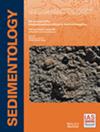流动诱导的界面变形结构(FIDS):对古流、流动动力学和基质流变学解释的影响
IF 2.8
2区 地球科学
Q1 GEOLOGY
引用次数: 0
摘要
浊积岩和其他类型海床底部的底面结构通常分为冲刷痕迹和工具痕迹,如凹槽、沟槽、撇痕和突痕。然而,还有一系列与冲刷或工具无关的常见底痕,人们对它们的起源知之甚少。这些鞋底结构中最突出的是纵向的脊和沟,以及与泥浆波纹相关的 "恐龙皮 "结构。本文对这些特征进行了描述,并认为它们是沉积物重力流过程中基底变形的产物。在这些流动诱导的界面变形结构(FIDS)中,软粘性基底会因凌空流动的较高密度基底部分所产生的浮力而发生变形,流动通过剪切力与这种浮力变形相互作用,从而重塑基底。这些浮力和剪切力的相对强度的变化解释了为什么会形成各种各样的 FIDS。这种 FIDS 模型重新解释了以前被归类为冲刷痕迹的纵脊和纵沟的形成,并解释了其独特的空间模式。此外,新模型建立在 Dżułyński 及其同事在 20 世纪 60 和 70 年代的开创性工作基础之上,他们发现这些结构包含关键的古海流信息,并认为这些信息在很大程度上未得到充分利用。重要的是,除了作为古水流指标的作用之外,FIDS 还能让人们深入了解其形成时的基底流变学,从而了解形成流中基底流动条件的性质。本文章由计算机程序翻译,如有差异,请以英文原文为准。
Flow‐induced interfacial deformation structures (FIDS): Implications for the interpretation of palaeocurrents, flow dynamics and substrate rheology
Sole structures on the base of turbidites, and other bed types, are typically classified into scour marks and tool marks, such as flutes, grooves, skim marks and prod marks. Yet, there are a range of other common sole marks that are unrelated to scouring or tools, and whose origin is poorly understood. Prominent among these sole structures are longitudinal ridges and furrows, and ‘dinosaur leather’ structures associated with mud ripples. Herein, these features are described and it is argued that they are the product of deformation of the substrate during a sediment gravity flow event. In these flow‐induced interfacial deformation structures (FIDS), a soft cohesive substrate undergoes deformation in response to a buoyant force induced by the denser basal component of an overriding flow, and the flow interacts with this buoyant deformation through shear to remould the substrate. Variations in the relative strength of these buoyant and shear‐induced forces explain the wide range of FIDS that can form. This FIDS model reinterprets the formation of longitudinal ridges and furrows, which have previously been classified as scour marks, and explains their distinctive spatial patterns. Furthermore, the new model builds on the seminal work of Dżułyński and colleagues in the 1960s and 1970s, who identified that these structures contain key palaeocurrent information, and it is argued that such information is largely under‐utilized. Importantly, alongside their utility as palaeocurrent indicators, FIDS provide insights into the rheology of the substrate at the time of their formation, and thus the nature of basal flow conditions in the formative flows.
求助全文
通过发布文献求助,成功后即可免费获取论文全文。
去求助
来源期刊

Sedimentology
地学-地质学
CiteScore
8.20
自引率
11.40%
发文量
94
审稿时长
6-12 weeks
期刊介绍:
The international leader in its field, Sedimentology publishes ground-breaking research from across the spectrum of sedimentology, sedimentary geology and sedimentary geochemistry.
Areas covered include: experimental and theoretical grain transport; sediment fluxes; modern and ancient sedimentary environments; sequence stratigraphy sediment-organism interaction; palaeosoils; diagenesis; stable isotope geochemistry; environmental sedimentology
 求助内容:
求助内容: 应助结果提醒方式:
应助结果提醒方式:


